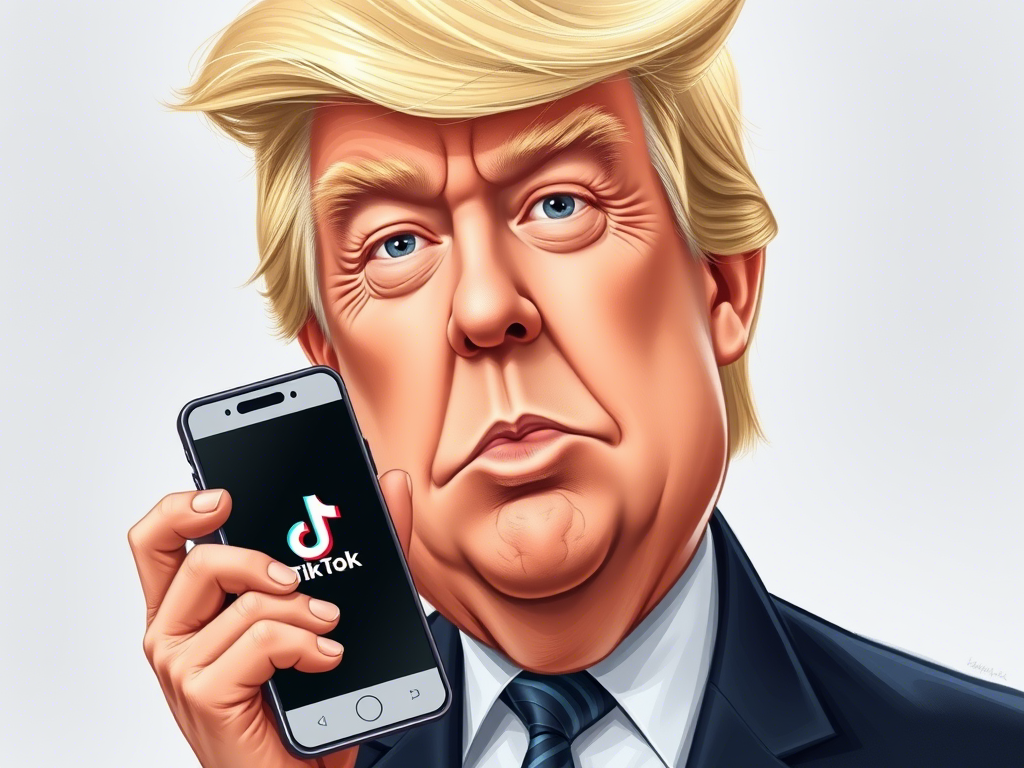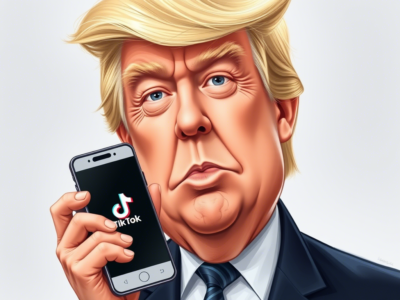In the ever-evolving world of technology and geopolitics, few stories have captured global attention quite like the saga of TikTok. Since its explosive rise as a cultural phenomenon, the short-video app has been at the center of debates about data privacy, national security, and international diplomacy. In a surprising turn of events, former President Donald Trump announced plans to speak directly with Chinese leaders to find a way to keep TikTok “alive” in the United States. This development marks a significant shift in the narrative surrounding one of the most contentious issues of his presidency.
This blog post delves into the details of Trump’s announcement, examines the implications for U.S.-China relations, and explores what this means for TikTok users, businesses, and the broader tech industry.
The Backstory: TikTok’s Rise and Controversies
TikTok, owned by the Chinese company ByteDance, launched globally in 2017 and quickly became a sensation. Its user-friendly interface, addictive algorithm, and emphasis on creativity made it an instant hit among younger generations. By 2020, TikTok had amassed over 1 billion active users worldwide, making it one of the fastest-growing social media platforms in history.
However, TikTok’s meteoric rise was accompanied by growing concerns from Western governments, particularly the United States. Critics argued that the app posed a threat to national security due to its ties to the Chinese government and its handling of user data. These fears came to a head during Trump’s presidency, when he issued an executive order banning TikTok from operating in the U.S., citing potential risks to American citizens’ personal information.
ByteDance pushed back against the ban, proposing various solutions, including selling a stake in TikTok to American companies or restructuring its operations to comply with U.S. regulations. Despite these efforts, tensions between Washington and Beijing remained high, leaving TikTok’s future uncertain.
Trump’s Announcement: A New Approach
In a surprising move, Trump revealed plans to engage in direct talks with Chinese leaders to resolve the TikTok issue. According to reports, the president believed that a negotiated solution could address U.S. security concerns while allowing TikTok to continue operating in the country. This approach marked a departure from his previous hardline stance and suggested a willingness to compromise in the interest of preserving the popular app.
While specifics of the proposed agreement were not immediately disclosed, several possibilities emerged:
- Data Localization : One option involved requiring TikTok to store all U.S. user data on servers located within the United States, managed by American companies. This measure aimed to reduce the risk of sensitive information falling into foreign hands.
- Ownership Restructuring : Another possibility was for TikTok to partner with or sell a majority stake to U.S.-based firms such as Oracle or Walmart. Such a deal would give American entities greater control over the platform’s operations and decision-making processes.
- Stricter Oversight : A third alternative included implementing additional oversight mechanisms to monitor TikTok’s compliance with U.S. laws and regulations. This might involve regular audits, transparency reports, and penalties for noncompliance.
Regardless of the exact terms, Trump’s willingness to negotiate signaled a recognition of TikTok’s importance to millions of Americans who rely on the app for entertainment, education, and even livelihoods.
Implications for U.S.-China Relations
The TikTok controversy is more than just a business dispute—it reflects deeper tensions in U.S.-China relations. For years, the two nations have clashed over trade policies, intellectual property rights, and technological dominance. The fate of TikTok serves as a microcosm of these larger issues, highlighting the challenges of balancing economic interests with national security concerns.

By proposing talks with China, Trump demonstrated a pragmatic approach to resolving disputes. Instead of pursuing outright bans or sanctions, he sought a middle ground that could satisfy both sides. This strategy aligns with his administration’s broader goal of fostering fairer trade relationships while protecting American interests.
At the same time, the negotiations underscored the increasing interconnectedness of global markets. As technology continues to blur borders, countries must find ways to collaborate rather than isolate themselves. The outcome of Trump’s discussions with China could set a precedent for future dealings involving multinational corporations and digital platforms.
What Does This Mean for TikTok Users?

For the millions of people who use TikTok daily, Trump’s announcement brought hope and relief. Many feared that a complete ban would deprive them of a beloved platform where they share creative content, connect with friends, and discover new trends. With the possibility of a negotiated settlement, users can breathe easier knowing that their favorite app may survive after all.
However, some changes are likely on the horizon. Depending on the final agreement, TikTok might undergo structural reforms, such as increased data encryption, enhanced privacy settings, or altered content moderation policies. While these adjustments aim to enhance user safety and trust, they could also impact the overall experience of using the app.
Moreover, the negotiations highlight the importance of staying informed about the apps we use. As consumers, it’s crucial to understand how our data is collected, stored, and shared—and to advocate for stronger protections when necessary.
Business Implications: Opportunities and Challenges
Beyond individual users, TikTok plays a vital role in the marketing strategies of countless businesses. Brands leverage the platform to reach younger demographics through engaging videos, influencer partnerships, and targeted ads. A resolution to the TikTok crisis ensures that companies can continue utilizing this powerful tool to grow their audiences and drive sales.
That said, the ongoing uncertainty surrounding TikTok’s future presents challenges for advertisers. Some may hesitate to invest heavily in campaigns until the situation stabilizes, fearing potential disruptions if another ban or restriction occurs. Others may explore alternative platforms to diversify their digital presence.
For ByteDance, the negotiations represent both an opportunity and a challenge. On one hand, securing TikTok’s survival in the U.S. market preserves its position as a global leader in social media innovation. On the other hand, meeting U.S. demands may require compromises that affect its autonomy and profitability.
Criticism and Skepticism
Not everyone welcomed Trump’s decision to negotiate with China. Critics argued that engaging with Beijing legitimizes its influence over American affairs and undermines national security. They questioned whether any agreement could truly eliminate the risks associated with TikTok’s connection to the Chinese government.
Others expressed skepticism about the feasibility of implementing effective safeguards. Given the complexity of modern technology, ensuring complete protection of user data is no small feat. Even with stringent measures in place, there’s always a chance that vulnerabilities could be exploited.
Despite these concerns, proponents of the negotiations emphasized the need for practical solutions. Rather than focusing solely on eliminating perceived threats, they advocated for finding ways to coexist peacefully in an increasingly interconnected world.
Looking Ahead: What’s Next for TikTok?
As talks between the U.S. and China progress, several scenarios could unfold:
- Successful Negotiation : If both parties reach an agreement, TikTok will likely remain operational in the U.S., albeit with modifications to its structure or operations. This outcome would bring stability to users and businesses alike.
- Partial Restrictions : In case full compliance proves impossible, partial restrictions—such as limiting certain features or functionalities—might be imposed. While less ideal, this compromise could still allow TikTok to function effectively.
- Failure to Agree : Should negotiations break down, the original ban could be reinstated, forcing TikTok to exit the U.S. market entirely. Although unlikely given recent developments, this scenario remains a possibility.
Regardless of the ultimate result, the TikTok saga highlights the critical role of technology in shaping modern diplomacy. It also underscores the responsibility of governments and corporations to prioritize transparency, accountability, and public welfare in their decisions.
Conclusion: A Lesson in Global Connectivity
When Donald Trump announced plans to speak with China and keep TikTok “alive,” he acknowledged the intricate web of relationships binding nations together in today’s digital age. From politics to economics to culture, every decision made in one corner of the globe reverberates across others.
For TikTok users, businesses, and policymakers, this moment serves as a reminder of the power—and pitfalls—of technology. As we navigate these uncharted waters, let us strive for solutions that balance innovation with integrity, progress with caution, and collaboration with resilience.

